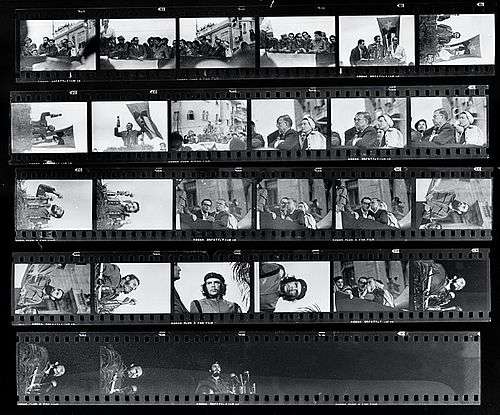La Coubre explosion
The French freighter La Coubre (French: [la kubʁ]) exploded in the harbour of Havana, Cuba, on 4 March 1960 while it was unloading 76 tons of grenades and munitions. Casualties may have been as high as 100, and many more were injured. Fidel Castro charged it was an act of sabotage on the part of the United States, which denied any involvement.

Events
Unloading explosive ordnance directly onto the dock in Havana was against port regulations. Ships with such cargoes were supposed to be moored in the center of the harbor and their high-risk cargo unloaded onto lighters.[1] La Coubre, a 4,310-ton French vessel, was unloading her cargo of 76 tons of Belgian munitions she had transported from the port Antwerp (Anvers or Amberes in Spanish) in Belgium to Havana (via Le Havre) when she exploded at 3:10 pm on 4 March 1960. Thirty minutes after the first explosion, while hundreds of people were involved in a rescue operation organized by the Cuban military, a second, more powerful explosion resulted in additional fatalities and injuries.[lower-alpha 1]
At the time of the explosion, Che Guevara (who was a trained doctor) was in a meeting at the National Institute of Agrarian Reform (NIAR, INRA as originally named in Spanish) headquarters. He drove to the scene and spent the next few hours giving medical attention to the crew members, armed forces personnel, and dock workers who had been injured.[3] The death toll was between 75 and 100; more than 200 people were injured.[4]
Reaction
Speaking the next day at a funeral for 27 dock workers killed by the explosions, Fidel Castro said that the United States was responsible for the explosion, "the work of those who do not wish us to receive arms for our defense",[5] a charge U.S. Secretary of State Christian Herter denied on 7 March in a meeting with the Cuban chargé d'affaires in Washington followed by a formal note of protest delivered to Cuban Foreign Minister Raul Roa on 15 March.[6] On 7 March, the Miami Herald reported charges made by Jack Lee Evans, an American who had just returned from Havana where he had been working for and living with William Alexander Morgan, an American who had commanded rebel forces during the Cuban Revolution. He said he had boarded the La Coubre on 2 March with Morgan and others to transport machine guns and ammunition to the NIAR. He then learned of a plot by an anti-Communist dockworker to explode the ship, did not think Morgan was involved, and now feared for his life. Morgan denied ever being aboard the ship and said of Evans: "The kid has to be out of his mind to say a thing like that."[7] Morgan was arrested seven months later, accused of supporting counter-revolutionaries, and executed in March 1961.[8]
Fate of La Coubre
La Coubre, named for a point of land along the Atlantic coast of France, Pointe de la Coubre, was towed to a dry-dock in Havana Harbor where she underwent extensive temporary repairs for five months to make her possible to be towed to France. 22 August 1960 La Coubre was towed by the dutch merchant Oostzee out to sea and arrived at the French port Le Havre at 26 September 1960. Two tugboats moved La Coubre to the French port Ruán in the Seine. Here she underwent her permament repair which were finalized in April 1961. When returned to service she continued to be owned and operated by the French Compagnie Générale Transatlantique until 1972, when she was sold to the Dorothea shipping company in Cyprus and renamed Barbara. Later the vessel was renamed Notios Hellas and Agia Marina until 1979 when she was sold to a Spanish company to be scrapped. [9]
Alberto Korda took photos at the memorial service for victims of the La Coubre explosion, including Guerrillero Heroico, which has become an iconic image of Che Guevara.[10]
Notes
- Father John McKniff, a Roman Catholic missionary priest, was thrown to the pavement by the second explosion. Although stunned, he survived and continued his work. He is under consideration for sainthood by the Catholic Church.[2]
References
- Fursenko, Aleksandr; Naftali, Timothy J. (1998). One Hell of a Gamble: Khrushchev, Castro, and Kennedy, 1958-1964. New York: W.W. Norton & Company, Inc. p. 40. ISBN 0-393-31790-0.
- "El cura de 'La Coubre' a un paso de la canonización". Miami Herald (in Spanish). 18 December 2000. Archived from the original on 14 June 2006. Retrieved 29 November 2006.
- "04 March 1960". Che en el tiempo Archived 2007-09-27 at the Wayback Machine, accessed 27 September 2006
- Phillips, R. Hart (5 March 1960). "75 Die in Havana as Munitions Ship Explodes at Dock". The New York Times. Retrieved 8 October 2011.
- Phillips, R. Hart (6 March 1960). "Castro Links U.S. to Ship 'Sabotage'; Denial is Swift" (PDF). New York Times. Retrieved 21 March 2016.
- "U.S. Note Is Delivered" (PDF). New York Times. 16 March 1960. Retrieved 21 March 2016.
- "Dockworker set ship blast in Havana, American claims". Miami Herald. 7 March 2016.
- Grann, David (28 May 2012). "The Yankee Comandante". The New Yorker. Retrieved 22 March 2016.
- Gutiérrez Gonzáles, Tomás (2017). La explosión de La Coubre. Frente al terror: Patria o muerte. La Habana: Editorial Capitán San Luis. p. 112. ISBN 978-959-211-483-8.
- The Story Behind Che’s Iconic Photo